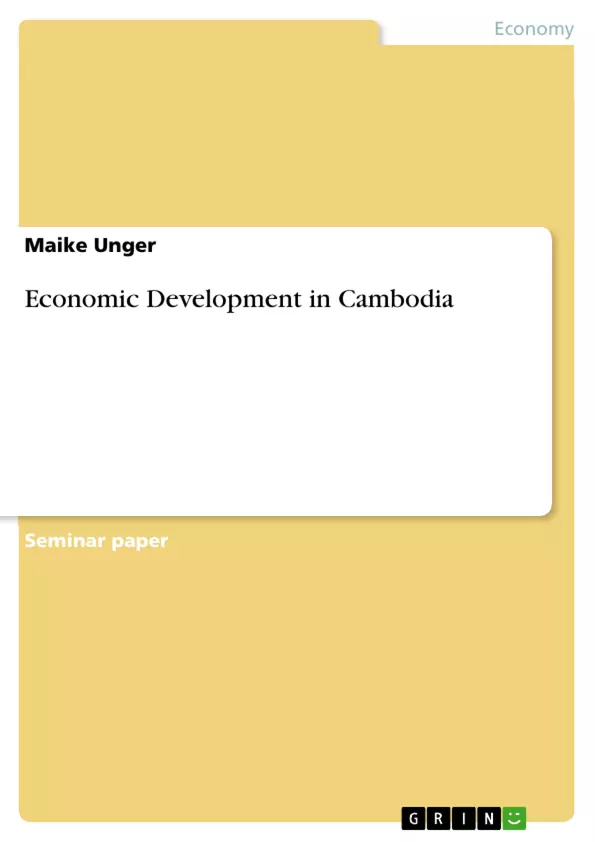Table of Contents 2
1. Introduction 3
2. Poverty and Inequality 6
3. Population Growth and Demographic Change 8
4. Conclusion 10
References 12
Table of Contents
- 1. Introduction
- 2. Poverty and Inequality
- 3. Population Growth and Demographic Change
- 4. Conclusion
Objectives and Key Themes
This paper aims to provide an overview of economic development in Cambodia, considering its historical context and current challenges. The analysis focuses on understanding the factors contributing to Cambodia's economic state and the interplay of various economic and social issues.
- The impact of the Khmer Rouge regime on Cambodia's development.
- Poverty, inequality, and their relationship to economic growth.
- Population dynamics and their influence on resource allocation and economic opportunities.
- The role of foreign investment and international aid in shaping Cambodia's economy.
- Environmental challenges and their implications for sustainable development.
Chapter Summaries
1. Introduction: This introductory chapter sets the stage by providing a geographical and historical overview of Cambodia. It establishes Cambodia's status as a low-income country, highlighting the devastating impact of the Khmer Rouge regime on its infrastructure and human capital. The chapter introduces key challenges facing the nation, including widespread poverty, corruption, and inequality, all stemming from the aftermath of the prolonged period of civil war. It also touches upon the current political structure, a multiparty democracy under a constitutional monarchy, and the ongoing issues related to political and economic corruption despite efforts toward international reintegration.
2. Poverty and Inequality: This chapter delves into the pervasive issues of poverty and inequality within Cambodia. It highlights the high rates of illiteracy, particularly in rural areas, and the growing problem of landlessness, exacerbated by insecure land ownership and leading to various conflicts. The chapter explores the lack of sufficient natural resources and the devastating environmental challenges, particularly deforestation and overfishing, threatening the fragile ecosystem. Despite robust GDP growth fueled by sectors like tourism and garment exports, this growth is unevenly distributed, concentrating wealth in urban areas while neglecting the rural population's needs. The chapter emphasizes the exploitation of Cambodian workers, particularly women in the garment industry, by both Western and Chinese firms, leading to economic imbalances and social injustices.
3. Population Growth and Demographic Change: While not explicitly detailed in the provided text, this chapter would likely discuss Cambodia's demographic trends, their impact on economic development, and their connection to issues raised in previous chapters such as poverty, resource availability, and land ownership. This would involve examining birth rates, mortality rates, migration patterns, and their effects on resource allocation and the country's capacity for economic growth. The analysis would likely incorporate how population density influences issues such as access to education, healthcare, and employment opportunities.
Keywords
Cambodia, economic development, poverty, inequality, Khmer Rouge, population growth, deforestation, overfishing, foreign investment, garment industry, corruption, political stability, sustainable development, land ownership, international aid.
Frequently Asked Questions: Cambodia's Economic Development
What is the overall focus of this document?
This document provides a comprehensive preview of a paper analyzing economic development in Cambodia. It includes the table of contents, objectives, key themes, chapter summaries, and keywords. The analysis focuses on understanding the factors contributing to Cambodia's economic state and the interplay of various economic and social issues.
What are the key themes explored in the paper?
The key themes include the impact of the Khmer Rouge regime, poverty and inequality, population dynamics, the role of foreign investment and international aid, and environmental challenges. The paper examines how these factors interact to shape Cambodia's economic trajectory.
What is covered in the Introduction chapter?
The introduction provides a geographical and historical overview of Cambodia, highlighting its status as a low-income country and the devastating impact of the Khmer Rouge regime. It introduces key challenges like poverty, corruption, inequality, and ongoing issues related to political and economic corruption despite efforts towards international reintegration.
What are the main points discussed in the chapter on Poverty and Inequality?
This chapter examines the high rates of poverty and inequality in Cambodia, focusing on issues like illiteracy, landlessness, lack of natural resources, environmental challenges (deforestation and overfishing), and uneven distribution of wealth from economic growth concentrated in urban areas. It also highlights the exploitation of Cambodian workers, particularly women in the garment industry.
What is the anticipated content of the chapter on Population Growth and Demographic Change?
While not explicitly detailed, this chapter is expected to discuss Cambodia's demographic trends and their impact on economic development. This includes birth rates, mortality rates, migration patterns, and their effects on resource allocation and the country's capacity for economic growth. It would likely connect population density to access to education, healthcare, and employment opportunities.
What are the key words associated with this paper?
The keywords include Cambodia, economic development, poverty, inequality, Khmer Rouge, population growth, deforestation, overfishing, foreign investment, garment industry, corruption, political stability, sustainable development, land ownership, and international aid.
What is the overall goal of the paper on Cambodia's economic development?
The paper aims to provide an overview of economic development in Cambodia, considering its historical context and current challenges. It seeks to understand the factors contributing to Cambodia's economic state and the interplay of various economic and social issues.
What specific aspects of Cambodia's economic development are addressed?
The paper addresses various aspects including the historical impact of the Khmer Rouge, current levels of poverty and inequality, population dynamics and their effects, the role of foreign investment and aid, and environmental challenges to sustainable development.
- Citation du texte
- Maike Unger (Auteur), 2007, Economic Development in Cambodia, Munich, GRIN Verlag, https://www.grin.com/document/136305



